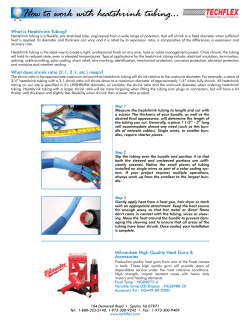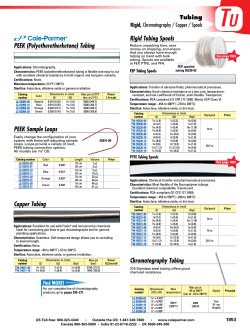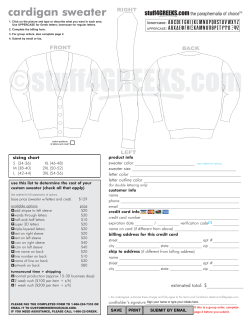
Heat-Shrink Tubing: The Versatile Tools for Maintenance and Repair
Heat-Shrink Tubing: The Versatile Tools for Maintenance and Repair Think of heat-shrink tubing as the duct tape for electrical wiring on the factory floor. Heatshrink tubing is versatile, easy to use, and finds wide applicability in maintenance and repair. Heat-shrink tubing can be used for preventive maintenance to avoid problems, and it is a wonderful tool for making minor repairs to cables and connectors. Insulate wire terminations, connections, and entire printed circuit boards, from electrical and environmental conditions. Heat-shrink tubing has excellent electrical properties. Repair cable splices, insulation damage and cuts, cable jackets, and connections, with permanent or temporary quick repairs. Because heat-shrink tubing has insulating properties equivalent to wire insulation, it can be easily applied over cut or worn insulation. In some cases, such repairs are temporary until the cable can be replaced. In other cases, the repair is permanent. Relieve strain on cables and connectors to prevent harmful flexing or bending. Flexing at the wire-to-terminal crimp can lead reduced performance or to failure. Conductor can become nicked or broken; insulation can be damaged. While many terminals and connector backshells have built-in strain relief, heat-shrink tubing can be used either as a supplement to the built-in strain relief or as a primary strain relief. Semirigid tubing is available to provide a stiffer strain relief. Bundle and organize wire harness, cable, tubing, and hose dressing. Seal connections, backshells, and gaps from moisture and other contaminants. Identify circuits through color coding, grouping, and labeling. Some tubing can be printed on directly. Others accept labels, usually designed specifically for use with tubing. Marking can be permanents, not smearing or fading before or after shrinking. Protect substrates from moisture, UV light, corrosion, oxidation, dust, chemicals, abrasion, environmental conditions, solder joints, and encapsulate. Heat-shrink tubing is available in a range of materials to meet nearly any electrical, mechanical, or environmental need. The Versatility of Heat Shrink Tubing www.alphawire.com Page 1 While heat-shrink tubing is widely used by OEMs in high-volume production, it’s also an essential item in any toolkit. Figure 1. Heat-shrink tubing serves multiple purposes: here it protects the termination area from contamination, adds strain relief, and identifies circuits through color coding. The name heat-shrink tubing pretty much sums up what it is and does: a plastic tube that shrinks permanently when heat is applied. How much it shrinks is determined by its shrink ratio, commonly ranging from 2:1 to 6:1. A 2:1 shrink ratio means that a tube will shrink to half its original diameter: a half-inch-diameter sleeve will shrink to one-quarter inch. The same halfinch sleeve with a 3:1 ratio will shrink to one-sixth of an inch. Tubing is typically made by forming a tube and exposing it to intense radiation (irradiated), during which it is expanded to a larger size. The expanded tubing is what you buy. The expanded tubing has “memory,” so that when it heated it will return to its original state. The Versatility of Heat Shrink Tubing www.alphawire.com Page 2 Figure 2. Heat-shrink tubing can be used to repair worn and damaged wire and cable. Picking the right heat-shrink tubing Heat-shrink tubing is available in a seemingly bewildering array of materials and options. But for the plant floor, a few of the general-purpose materials will usually cover most needs. The most popular material is polyolefin, which can be used unless your requirements have special considerations. Here are some of the considerations in choosing the proper heat-shrink tubing: Shrink ratio. A high shrink ratio will allow the sleeve to be fit over larger objects, such as connectors, and then shrunk down to the smaller diameter of a cable. Generally, though, don’t use a higher ratio than your application requires. Sleeve diameter: The final shrink diameter should be smaller than the object that the sleeve is applied to. Put another way, you don’t want to shrink the sleeve completely. The sleeve should shrink tightly against the object, which won’t happen if the object is smaller than the final shrink diameter. Wall thickness: Heat-shrink sleeves come in various thicknesses. A thicker wall provides more abrasion resistance, rigidity, and ability to withstand wear and tear. If you don’t need such robustness, a thin-wall sleeve is fine. The Versatility of Heat Shrink Tubing www.alphawire.com Page 3 Stiffness: Different sleeves have different degrees of flexibility. A more rigid sleeve is a good choice of achieving a strain relief on a connector or terminal, where reducing flexing is one goal of the heat-shrink tubing. Sealing: Heat-shrink tubing, properly applied, will seal the interface between tubing and object. If sealing is important, choose a material that will withstand any unique contaminants. For the best shielding, try to limit the shrinking to 75% to 80% of maximum. For a 0.500 sleeve with a 2:1 shrink ratio, the object should not be less than 0.32 inch to ensure proper sealing. Some heat-shrink tubing features an adhesive or meltable inner layer for applications that require maximum sealing. In most cases, standard tubing will provide adequate sealing, but adhesive lined tubing goes a step further. Shrink temperature: Common polyolefin materials have a recommended shrink temperature of around 90°C, although other materials offer shrink temperatures, notably Teflon, as high as 250°C. The usual considerations: You, of course, must the basic application requirements of voltage, operating temperature range, and other typical concerns in any application. You also need to consider special application needs, such as resistance to chemical and oils. Application guidelines Make sure you have the right tubing for your needs. It’s a good idea to keep and assortment of tubing handy for maintenance and repair work. Vendors like Alpha Wire offer kits containing a variety of sizes and colors. Use a tubing diameter that will not provide full shrinking. If you are repairing a damaged jacket, make sure the cable is otherwise still in good shape. Make sure the insulation around separate conductors is not harmed and that there is no possibility of shorts or opens. Likewise, make sure that conductors are not nicked. If you are sealing, consider a dual-wall tube that has an adhesive or meltable inner layer. Use a proper heat source. Heat guns especially designed for heat-shrink tubing are available. Their advantage is that they give you control both temperature and air flow. A butane torch is sometimes used. The Versatility of Heat Shrink Tubing www.alphawire.com Page 4 Apply heat evenly. Most often moving from one end of the tube to the other works well. You should also apply heat in a full 360°C around the tubing. This may not always be possible, but cover as much of the tubing with heat as possible. Figure 3. Heat-shrink tubing can be easily applied to irregular surfaces Common heat-shrink materials and properties Figure 4 summarizes the range of heat-shrink tubing available from Alpha Wire. You can see that, while Irradiated polyolefin is the most common general-purpose material, a wide range of other materials meets special needs. The Versatility of Heat Shrink Tubing www.alphawire.com Page 5 Material Features Shrink Temp. Shrink Ratio Alpha Wire FIT Family 90°C 110°C 90°C 121°C 2:1 3:1 4:1 6:1 2:1 3:1 FIT-221 FIT-321 FIT-421 FIT-621 FIT-221V FIT-321V 2:1 FIT-260 2:1 FIT-295 3:1 to 6:1 FIT-300 2:1 FIT-700 2:1 FIT-750 2:1 FIT-105 2:1 FIT-350 1.2:1 FIT-400 1.5:1 FIT-500 1.75:1 FIT-600 2:1 FIT-650 2:1, 3:1 FIT Fab 1.7:1 FIT Flex Single-Wall Irradiated Polyolefin for General-Purpose Use Irradiated polyolefin General purpose HST Range of shrink ratios Low shrink temp 90°C Passes UL VW-1 flame test Approved for 600-V ground lead identification Irradiated polyolefin Green with yellow stripe 90°C Passes UL VW-1 flame test Semirigid irradiated 30% stronger and 25% stiffer than standard 130°C polyolefin polyolefin Dual-Wall Polyolefin for Additional Sealing Surface irradiated, dual Meltable inner wall to encapsulate without adhesive 140°C extruded Bonds to most materials Bonding, mastic lined 120°C High voltage: to 2 kV Bonding, adhesive lined Permanent water and corrosion protection 110°C Special-Application Tubing Low shrink temp Irradiated PVC Passes UL VW-1 flame test 100°C 30% stronger than standard polyolefin High shrink temperature with fast recovery time Excellent chemical, heat, and flame resistance Irradiated Kynar 170°C Passes UL VW-1 flame test 3x the tensile strength of standard polyolefin High shrink temperature Excellent chemical resistance Teflon FEP 200°C Excellent dielectric properties Thinnest wall thickness available High shrink temperature Excellent chemical resistance Teflon TFE 250°C Excellent dielectric properties Very thin wall thickness Highly flexible Irradiated elastomer 130°C Oil and abrasion resistant; Passes UL VW-1 flame test High shrink temperature Irradiated Viton Excellent chemical resistance 120°C Flexible Superior abrasion resistance Excellent flexibility 110°C Woven fabric Resists harsh environments High flexibility available Pliable 200°C Irradiated silicone rubber Scrape abrasion resistant; Passes UL VW-1 flame test Figure 4. Heat-shrink tubing is available in a wide range of materials to meet any MRO need. Flame-retardant irradiated polyolefin The Versatility of Heat Shrink Tubing www.alphawire.com Page 6 GLOBAL HEADQUARTERS 711 Lidgerwood Avenue Elizabeth, NJ 07207-0711 USA Toll Free: 1-800-52 ALPHA Tel: 1-908-925-8000 Fax: 1-908-925-5411 E-mail: info@alphawire.com EUROPE Alpha Wire International Sunbury Int’l Business Centre, Brooklands Close Windmill Road, Sunbury-on-Thames, Middlesex United Kingdom TW16 7DX Tel: +44 (0) 800 288 8809 Fax: +44 (0) 800 288 8810 E-mail: europe@alphawire.com ©2009 Alpha Wire. All rights reserved. Teflon and Viton are registered trademarks of E. I. du Pont de Nemours and Company. Kynar is a registered trademark of Arkema Inc. The Versatility of Heat Shrink Tubing Lit. No: FITMRO-WP-0901 Supersedes: New www.alphawire.com Page 7
© Copyright 2025














